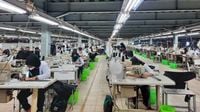Indonesia is bracing for significant economic challenges as President Donald Trump imposes a hefty 32% reciprocal tariff on its exports, a move that could severely impact the nation’s trade balance and industries reliant on the U.S. market. This decision, part of Trump’s broader trade war strategy, is set to take effect on April 9, 2025, and has raised alarms among economists and business leaders alike.
According to reports, the tariff is a response to the growing trade deficit the U.S. faces with Indonesia, which has surged by 67% over the past five years, reaching an estimated $14.34 billion in 2024. This figure is significantly higher than the $8.58 billion recorded in 2019, indicating a troubling trend for U.S.-Indonesia trade relations. The U.S. Department of Commerce estimates the deficit to be even larger, at $17.9 billion, highlighting the complexities of trade statistics.
Economic experts, including Eisha Maghfiruha Rachbini from the Institute for Development of Economics and Finance (Indef), warn that this tariff will directly hinder Indonesia’s ability to export key products to the U.S. market. “The implementation of tariffs on Indonesian exports to the U.S. will have a direct impact,” she stated, emphasizing that sectors such as textiles, footwear, electronics, and agricultural products like palm oil and rubber could see significant declines in demand.
Historically, Indonesia has enjoyed a trade surplus with the U.S., with figures climbing from $8.5 billion in 2019 to $16.84 billion in 2024. However, with the new tariff in place, the outlook appears bleak. The tariffs could lead to a trade diversion, where exporters shift focus from lower-cost markets to higher-cost ones, further complicating Indonesia’s economic landscape.
In addition to textiles and electronics, which are among the top exports to the U.S., other significant products include footwear, furniture, and fish. For instance, Indonesia exported $4.18 billion in electric machinery and equipment, $2.48 billion in knitted clothing, and $2.39 billion in footwear in 2024. These figures underline the importance of the U.S. market for Indonesian exporters, making the tariff increase particularly concerning.
"The impact of this policy is likely to slow production and lead to job losses in these sectors," Eisha added, suggesting that the Indonesian government must act swiftly to mitigate the fallout. She recommends that the government engage in immediate trade negotiations with the U.S. to reduce the tariff's impact and explore alternative markets to offset potential losses.
Hosianna Evalita Situmorang, an economist at Bank Danamon Indonesia, echoed these sentiments, stating, "The inclusion of Indonesia on the U.S. list of countries facing higher retaliatory tariffs may raise investment concerns for foreign investors. U.S. companies might reduce their investments in Indonesia as a result." This sentiment reflects broader worries about the long-term implications of trade relations between the two nations.
As the situation unfolds, the Indonesian government is urged to optimize bilateral and multilateral trade agreements, including Comprehensive Economic Partnership Agreements (CEPA) and new partnerships with non-traditional trading partners to bolster its export capacity. This proactive approach could help Indonesian exporters navigate the challenges posed by the new tariffs.
Moreover, the Indonesian Ministry of Trade has reported a notable increase in textile and textile product exports, which reached $1.02 billion in February 2025, a 1.41% rise from January of the same year. The largest increase in these exports was directed towards the U.S., amounting to $17.4 million, marking a 4.13% growth compared to the previous month. However, with the impending tariff, such growth could be jeopardized.
In light of these developments, businesses are encouraged to prepare for potential disruptions. The government is also advised to consider financial incentives, tax relief, and subsidies to help domestic industries cope with the increased costs and reduced demand stemming from the tariffs.
As Indonesia navigates these turbulent waters, the importance of diplomatic negotiations and strategic economic planning cannot be overstated. The nation’s ability to adapt to the changing trade landscape will be crucial in mitigating the adverse effects of the tariff and ensuring the continued growth of its export sectors.
The repercussions of Trump's trade policies extend beyond mere tariffs; they pose a fundamental challenge to Indonesia's economic stability and growth. As the country braces for these changes, the focus must remain on fostering resilience within its key industries and exploring new avenues for trade and investment.



